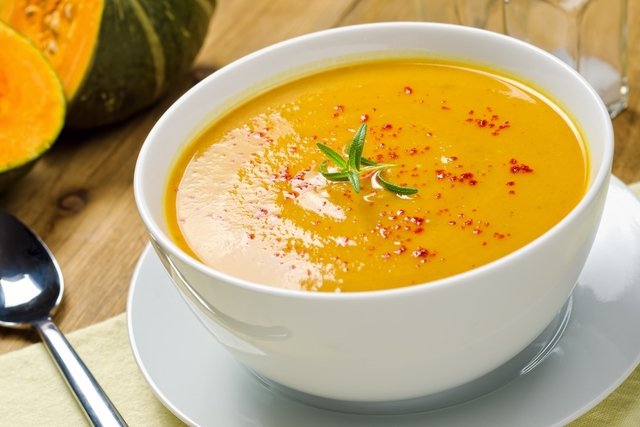A liquid diet is a type of diet recommended to prevent dehydration, facilitate digestion and prevent choking in people who cannot eat solid food, such as in cases of multiple sclerosis, Parkinson’s disease, stroke or after surgery, for example.
Furthermore, this diet is also recommended for preparing some tests, such as colonoscopy, which is a test recommended to assess intestinal health. Learn more about colonoscopy.
During the liquid diet, you should opt for liquid foods such as porridge, strained fruit juice, soup, tea, cream cheese and blended meat. Because the liquid diet can be very restricted, the use of dietary supplements may also be necessary during this diet.

When is it indicated
The liquid diet is recommended to prevent dehydration, facilitate digestion and prevent choking in people who cannot eat solid food. Thus, this type of diet is recommended in the following situations:
- Parkinson’s disease;
- Multiple sclerosis;
- Stroke;
- Anorexia;
- After surgeries, such as bariatric surgery, mouth, head and neck surgeries;
- Intestinal problems such as diarrhea and vomiting.
Furthermore, a liquid diet can also be recommended before surgeries and when preparing for exams, such as colonoscopy.
Does the liquid diet lose weight?
The liquid diet can help with weight loss by including the intake of healthy foods, such as fruit juice, lean meats and vegetables. However, as this diet is low in fiber, it increases hunger and, consequently, food intake during the day.
Furthermore, this diet can promote weight gain when you resume your normal diet. This is because the liquid diet does not promote nutritional re-education, which is a change in behavior, where you learn to make healthier food choices, avoiding the “accordion effect”. Understand more about nutritional re-education.
Therefore, when choosing to go on a diet to lose weight, it is recommended to consult a nutritionist, so that an assessment can be carried out and a diet suited to individual needs can be created.
How to make
The liquid diet is divided into two types and must be done according to each objective.
1. Complete liquid diet
The complete liquid diet is recommended for people who have difficulty chewing or swallowing food, such as in cases of anorexia, Parkinson’s disease and multiple sclerosis. Furthermore, this diet is also recommended for pre- and post-surgical periods and for preparing for certain exams.
The foods allowed on this diet are:
- Refined and cooked cereals, like oat porridge, creamed rice and corn;
- Blended and strained broths and soups, made with vegetables, proteins and legumes;
- Drinks, such as strained fruit juices, teas, water and coffee;
- Dairy, such as milk, yogurt, creamy white cheeses, such as cottage and cream cheese;
- Blended meats, such as chicken, fish, eggs and beef;
- Vegetable oils in moderation, such as olive or avocado oil and coconut oil;
- jellies, such as grapes, strawberries and pineapple.
The foods that should be avoided in this diet are solid foods, whole grains, sugar, seeds and oilseeds; raw and whole vegetables; whole fruits; hard, high-fat cheeses; sausages and meats rich in fat.
2. Restricted liquid diet
This diet helps prevent dehydration and rest the intestine, being recommended for problems such as diarrhea and vomiting, when preparing for exams, in the periods before and after surgeries and after the period of intravenous feeding, for example.
The restricted liquid diet does not contain fiber, in addition to being low in carbohydrates, proteins and fats, and is generally recommended for up to 3 days. The foods allowed on this diet are:
- Cooked and blended white rice;
- Strained vegetable broths;
- Beverages, such as water, clear teas, strained clear fruit juices, such as pear, cashew and pineapple;
- Fat-free chicken or beef broth;
- Gelatin;
- Vegetable oils in moderation, such as olive or avocado oil.
In this diet, you should avoid any solid food, all other types of cereals, beans, seeds and oilseeds, milk and dairy products, eggs, sugar, dark-colored fruit juices, such as mango, watermelon and grapes.
Liquid diet menu
The following table shows an example of a 3-day liquid diet menu:
It is important to remember that the liquid diet menu varies depending on the person’s general health and diet goals. Therefore, it is advisable to consult a nutritionist so that a complete assessment can be carried out and a diet suited to individual needs can be created.
As it is a very nutrient-restricted diet, the nutritionist may also recommend the use of nutritional supplements during liquid diets.
Possible side effects
Because it is very restricted, the liquid diet can cause weakness, dizziness, headache, nausea, irritability, dehydration, low blood pressure and blurred vision.
Furthermore, when carried out over a long period of time, the liquid diet can also alter the health of the intestinal flora and cause nutritional deficiencies.

Sign up for our newsletter and stay up to date with exclusive news
that can transform your routine!
Warning: Undefined array key "title" in /home/storelat/public_html/wp-content/plugins/link-whisper-premium/templates/frontend/related-posts.php on line 12
Warning: Undefined array key "title_tag" in /home/storelat/public_html/wp-content/plugins/link-whisper-premium/templates/frontend/related-posts.php on line 13



